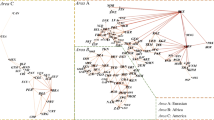Abstract
Geospatial information is collected from different sources thus making spatial ontologies, built for the same geographic domain, heterogeneous; therefore, different and heterogeneous conceptualizations may coexist. Ontology integrating helps creating a common repository of the geospatial ontology and allows removing the heterogeneities between the existing ontologies. Ontology mapping is a process used in ontologies integrating and consists in finding correspondences between the source ontologies. This paper deals with the “mapping” process of geospatial ontologies which consist in applying an automated algorithm in finding the correspondences between concepts referring to the definitions of matching relationships. The proposed algorithm called “geographic ontologies mapping algorithm” defines three types of mapping: semantic, topological and spatial.







Similar content being viewed by others
References
Bouquet P (2007) Contexts and ontologies in schema matching. Context and ontology representation and reasoning. Roskilde University, Denmark
Buccella A, Cechich A, Fillottrani P (2009) Ontology-driven geographic information integration: a survey of current approaches. Comput Geosci 35:710–723. doi:10.1016/j.cageo.2008.02.033
Calvanese D, Giacomo G, Lenzerini M (2001) Ontology of integration and integration of ontologies. In: Description logic workshop, pp 10–19
Chaabane S, Gargouri F (2013) Matching spatial ontologies: a challenge of formalization. In: 5th international conference on knowledge engineering and ontology development KEOD 2013, September, Vilamoura, Algarve, Portugal
Chaabane S, Jaziri W, Gargouri F (2008) OntoRoad: spatial ontology for the road domain. Journées Francophones sur les Ontologies (JFO’2008), Décembre, Lyon, France, pp 135–144
Cheatham M, Dragisic Z, Euzenat J, Faria D et al (2015) Results of the ontology alignment evaluation initiative 2015. Technical report OAEI 2015
Dragoni M (2015) Multilingual ontology mapping in practice: a support system for domain experts. In: International semantic web conference no. 2, pp 169–185
Du H, Anand S, Alechina N, Morley J, Hart G, Leibovici D, Jackson M, Ware M (2012) Geospatial information integration for authoritative and crowd sourced road vector data. Trans GIS 16:455–476
Du H, Alechina N, Jackson M, Hart G (2013) Matching formal and informal geospatial ontologies. In: Vandenbroucke D et al (eds) Geographic information science at the heart of Europe, lecture notes in geoinformation and cartography. Springer International Publishing, Switzerland. doi:10.1007/978-3-319-00615-:4-9
Egenhofer M (1994) Deriving the composition of binary topological relations. J Vis Lang Comput 5:133–149
Egenhofer M, Franzosa RD (1991) Point-set topological spatial relations. Int J GIS 5:161–174
Ehrig M, Staab S (2004) QOM-quick ontology mapping. In: The Semantic Web–ISWC, pp 683–697
Euzenat J, Shvaiko P (2007) Ontology matching. Springer, Heidelberg
Euzenat J, Shvaiko P (2013) Ontology matching. Springer, Heidelberg
Godugula S, Engels G (2008) Survey of ontology mapping techniques. Software quality and assurance. Retrieved from: is.uni-paderborn. Comparsion_of_Ontology_Matching_Techniques
Jain P, Hitzler P, Sheth AP, Verma K, Yeh PZ (2010) Ontology alignment for linked open data. In: International semantic web conference, pp 402–417
Kavouras M, Kokla M, Tomai E (2005) Comparing categories among geographic ontologies. Comput Geosci 31:145–154
Laurini R (2007) Pre-consensus ontologies and urban databases. In: Teller J, Lee JR, Roussey C (eds) Ontologies for urban development. Studies in computational intelligence, vol 61. Springer, Heidelberg, pp 27–36
Laurini R (2015) Geographic ontologies, gazetteers and multilingualism. Future Internet 7:1–23
Leveinshtein VI (1996) Binary codes capable of correcting deletions, insertions and reversals. Sov Phys Dokl 10:707–710
Lihua Z, Ryutaro I (2010) Aggregation of similarity measures in ontology matching. In: The fifth international workshop on ontology matching collocated with the 9th international semantic web conference (ISWC)
Madhavan J, Bernstein PA, Domingos P, Halevy A (2002) Representing and reasoning about mappings between domain models. In: Proceedings of the 18th national conference on artificial intelligence (AAAI’02), Edmonton, Alberta, Canada, August
Maedche A, Staab S (2002) Measuring similarity between ontologies. In: EKAW 2002, pp 251–263
McGuinness D, Fikes R, Rice J, Wilder S (2000) An environment for merging and testing large ontologies. In: Proceedings of the 17th international conference on principles of knowledge representation and reasoning (KR-2000), Colorado, USA, April 2000, pp 483–493
Miller GA (1995) WordNet: a lexical database for english. Commun ACM 38(11):39–41
Mitra P, Wiederhold G (2002) Resolving terminological heterogeneity in ontologies. In: Proceedings of the ECAI’02 workshop on ontologies and semantic interoperability, Lyon, France, July
Noy NF (2004) Semantic integration: a survey of ontology-based approaches. SIGMOD Rec 33(4):65–70
Noy NF, Musen MA (2000a) Algorithm and tool for automated ontology merging and alignment. In: Proceedings of the 17th national conference on artificial intelligence (AAAI-00). Available as SMI technical report
Noy NF, Musen MA (2000b) PROMPT: algorithm and tool for automated ontology merging and alignment. In: Proceedings of the 17th national conference on artificial intelligence (AAAI’00), Austin, TX, USA, July
Randell DA, Zhan C, Cohn AG (1992) A spatial logic based on regions and connection. In: Proceedings of the 3rd international conference on knowledge representation and reasoning, Cambridge, MA, USA, pp 165–176
Siricharoen WV, Pakdeetrakulwong U (2014) A survey on ontology-driven geographic information systems. In: Fourth international conference on digital information and communication technology and it’s applications (DICTAP), Bangkok, pp 6–8
Tran QV, Ichise R, Ho BQ (2011) Cluster-based similarity aggregation for ontology matching. In: Proceedings of 6th ontology matching workshop, pp 142–147
Volz S, Walter V (2004) Linking different geospatial databases by explicit relations. In: International society for photogrammetry and remote sensing (ISPRS) congress, communication, vol IV, pp 152–157
Author information
Authors and Affiliations
Corresponding author
Rights and permissions
About this article
Cite this article
Chaabane, S., Jaziri, W. A novel algorithm for fully automated mapping of geospatial ontologies. J Geogr Syst 20, 85–105 (2018). https://doi.org/10.1007/s10109-017-0263-0
Received:
Accepted:
Published:
Issue Date:
DOI: https://doi.org/10.1007/s10109-017-0263-0




